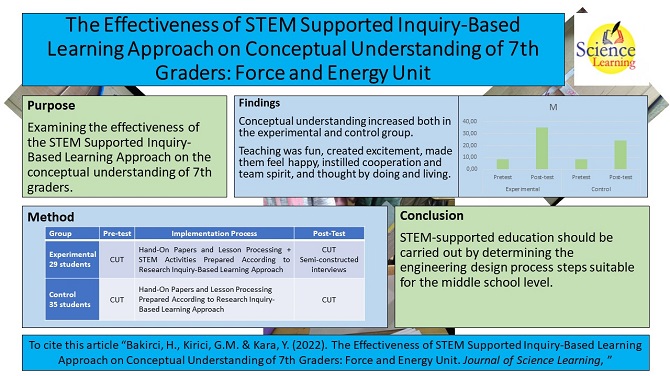
The Effectiveness of STEM-Supported Inquiry-Based Learning Approach on Conceptual Understanding of 7th Graders: Force and Energy Unit
Abstract
This research examines the effectiveness of the STEM Supported Inquiry-Based Learning Approach on the conceptual understanding of 7th graders. In the study, a mixed-method design was adopted. The research was carried out with 64 students studying in a secondary school. The study used a Conceptual Understanding Test (CUT) and an Interview Form as data collection tools. Quantitative data obtained in the research were analyzed using ANCOVA and T-test. Qualitative data were proceeded by subjecting them to content and descriptive analysis. Examining the study results, STEM Supported Inquiry-Based Learning Approach increased students’ conceptual understanding in the experimental group and the Inquiry-Based Learning Approach in the control group. It was determined that the science teaching in the experimental group was more effective in the conceptual understanding of 7th graders. The students stated that the science teaching in the experimental group was fun, created excitement, made them feel happy, instilled cooperation and team spirit, and thought by doing and living. Depending on the results obtained from the research, it was implicated that STEM-supported education should be carried out by determining the engineering design process steps suitable for the middle school level.
Full Text:
Download PDFReferences
Abraham, M. R., Grzybowski, E. B., Renner, J. W., & Marek, E. A. (1992). Understandings and misunderstandings of eighth graders of five chemistry concepts found in textbooks. Journal of Research in Science Teaching, 29, 105-120.
Bakırcı, H., & Çalık, M. (2013). Effect of guide materials developed in Adaptation and natural selection subject on remedying grade 8 students’ alternative conceptions. Education and Science, 38(168), 215-229.
Bakırcı, H., & Ensari, Ö. (2018). The effect of common knowledge construction model on academic achievement and conceptual understandings of high school students on heat and temperature. Education & Science, 43(196), 171-188.
Christensen, L. B. (2004). Experimental methodology. United States of America: Pearson Education.
Coştu, B., Ayas, A., & Suat, Ü. (2007). Misconceptions about boiling and their possible reasons. Kastamonu Education Journal, 15(1), 123-136.
Çepni, S. (2011). Introduction to research and project studies. Trabzon: Celepler Printing.
Demir, & Çökelez (2012). Investigation of the conceptual learning of 6th grade students on the concepts of mass, weight and gravity. X. National Science and Mathematics Education Congress, 27-30 June Nigde, Turkey.
Dumanoğlu, F. (2018). Effect of science, technology, engineering and mathematics activities on seventh grade students’ academic achievement and attitudes (Master’s thesis). Istanbul University, Turkey.
Faber, M., Unfried, A., Wiebe, E. N., Corn., J., & Collins, T. L. (2013, June). Student attitudes toward STEM: The development of upper elementary school and middle/high school student surveys. 120th ASEE Annual Conference & Exposition, 23-26 June, Atlanta, Georgia.
Felix, A. L., Bandstra, J. Z., & Strosnider, W. H. J. (2010h). Design-based science for stem student recruitment and teacher professional development. Mid-Atlantic ASEE Conference, 16-17 April, Easton, Pennsylvania.
Göloğlu-Demir, C., Tanık-Önal, N., & Önal, N. (2021). Investigation of middle school students’ attitudes towards science, technology, engineering and mathematics (STEM) education and determination of the predictors. Journal of Science Learning, 4(2), 101-112.
Gülhan, F., & Şahin, F. (2016). The effects of science-technology-engineering-math (STEM) integration on 5th grade students’ perceptions and attitudes towards these areas. International Journal of Human Science, 13(1), 602-620.
Honey, M., Pearson, G,. & Schweingruber, H. (2014). STEM integration in K-12 education: Status, prospects, and an agenda for research. Washington: The National Academies Press.
Hynes, M., Portsmore, M., Dare, E., Milto, E., Rogers, C., Hammer, D., & Carberry, A. (2011). Infusing engineering design into high school STEM courses. http://ncete.org/flash/pdfs/Infusing%20Engineering%20Hynes.
Irkıçatal, Z. (2016). STEM related after-school program actıvıtıes and assocıated outcomes on students success and on theır stem perceptıon and ınterest (Master’s thesis). Akdeniz University, Turkey.
Karahan, E., Canbazoglu-Bilici, S., & Ünal, A. (2015). Integration of media design processes in science, technology, engineering and mathematics education. Eurasian Journal of Educational Research, 60, 221-240.
Ministry of National Education [MoNE]. (2018). Science curriculum. Ankara: State Books Printing House.
Savran-Gencer, A. (2015). Scientific and engineering practices in science education: Twirly Activity Journal of Inquiry Based Activities, 5(1), 1-19.
Stylianidou, F., Ormerod, F., & Ogborn, J. (2002). Analysis of science textbook pictures about energy and pupils readings of them. International Journal of Science Education, 24(3), 257-283.
Taşdemir, A., & Demirbaş, M. (2010). The level of correlation of concepts that primary students seen topics in science and technology class with daily life. International Journal of Human Sciences, 7(1), 124-148.
Tiryaki, A., & Adıgüzel, S. (2021). The effect of STEM-based robotic applications on the creativity and attitude of students. Journal of Science Learning, 4(3), 288-297.
Wood, T. T., Knezek, G., & Christensen, R. (2010). Instruments for assessing interest in STEM content and careers. Journal of Technology and Teacher Education, 18(2), 341-363.
Yıldırım, B. (2016). An examination of the effects of science, technology, engineering, mathematics (stem) applications and mastery learning integrated into the 7th grade science course (PhD thesis). Gazi University, Turkey.
Yıldırım, A., & Şimşek, H. (2013). Qualitative research methods in the social sciences. Ankara: Seçkin Publishing.
Yıldırım, B., & Selvi, M. (2016). Examination of the effects of STEM education integrated as a part of science, technology, society and environment courses. Journal of Human Sciences, 13(3), 3684-3695.
Yürümezoğlu, K., Ayaz, S., & Çökelez, A. (2009). Grade 7-9 students’ perceptions of energy and related concepts. Necatibey Faculty of Education, Electronic Journal of Science and Mathematics Education, 3(2), 52-73.
DOI: https://doi.org/10.17509/jsl.v5i3.43647
Refbacks
- There are currently no refbacks.
Copyright (c) 2022 Hasan Bakirci, Merve Gül Kirici, Yilmaz Kara

This work is licensed under a Creative Commons Attribution-ShareAlike 4.0 International License.


Jl. Dr. Setiabudhi 229 Bandung 40154, West Java, Indonesia











